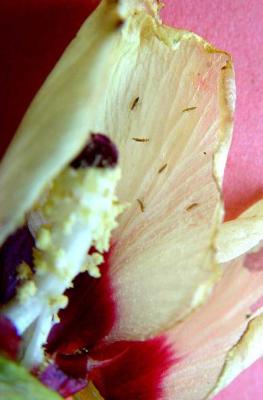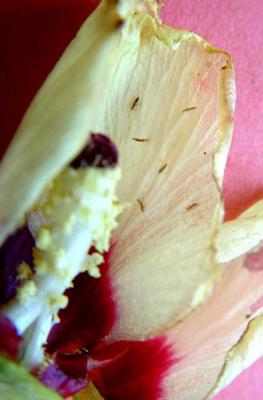

(Some species of Haplothrips are reported as pest in South Africa, we do not know if they are pests in Kenya or east Africa. Haplothrips are present in East Africa, but some of them are beneficial (predacious) and we do not know the status on the region. This will have to be reviewed when we finish with the datasheets). [br] When the status of Haplothrips in East Africa has been clarified we could decided if we leave this information on egg-laying habits. [br] Biological pesticides: check with list of Seif [br] FW: Include information on synthetic pesticides?
Thrips (Frankliniella spp.)
Thrips feed on the lower surface of leaves, flowers and fruits. Both larvae and adults puncture the leaves and suck the exuding sap. Heavily attacked leaves become curled, wrinkled and finally dry up. Any environmental stress that weakens the plants makes them more susceptible to thrips attack. Thrips attack on seedlings and young plants delays crop development. Feeding on the flowers may result in deformed pods. Attack on fruits may scar them. Affected fruits are not marketable.
- Conserve natural enemies. In particular predators (e.g. predatory bugs, mites and thrips) are important in natural control of thrips.
- Plough and harrow before planting. This exposes pupae in the soil to natural enemies and desiccation.
- If necessary, spray biopesticides. Spinosad, a bacterium metabolite, is effective in controlling thrips. Insecticides should only be used up to the early flowering stage. Spraying after flowering or a later stage may lead to pesticide residues on the pods. Observe preharvest intervals.
